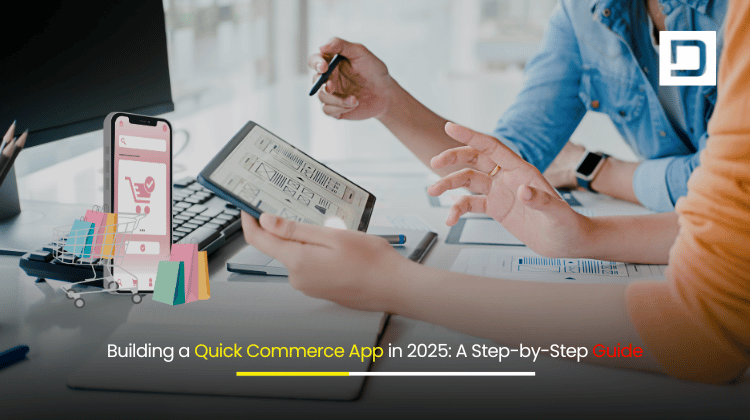Building a Quick Commerce App in 2025: A Step-by-Step Guide
The world of e-commerce is evolving rapidly, and Quick Commerce (Q-Commerce) is leading the charge in providing ultra-fast delivery services, bringing products to customers within hours or even minutes. As we move into 2025, businesses are realizing the potential of developing Quick Commerce apps to meet the increasing demand for convenience and speed.
Building a Quick Commerce app in 2025 requires a strategic approach to technology, user experience, and scalability. Whether you’re starting from scratch or upgrading your existing app, this step-by-step guide will walk you through the key considerations and best practices for building a successful Quick Commerce app that stands out in a competitive market.
Understanding Quick Commerce and Its Market Potential
Quick Commerce is an evolving trend where businesses focus on delivering products to consumers as quickly as possible, typically within a time window of 30 minutes to 1 hour. Unlike traditional e-commerce, Q-Commerce focuses on ultra-fast delivery for daily essentials, groceries, and other frequently needed items.
The rapid growth of the on-demand economy, along with advancements in technology, has created a high demand for Q-Commerce apps. In 2025, building an app that can handle fast deliveries, provide real-time tracking, and deliver a seamless user experience will be a crucial factor for success in this competitive market.
Step 1: Define Your Business Model and Niche
Before diving into the technical aspects of app development, it’s essential to define your business model and target niche. Will your Quick Commerce app focus on groceries, pharmaceuticals, electronics, or other everyday essentials? Understanding your niche will help you design a solution tailored to your audience’s needs.
Key considerations include:
- Target Audience: Are you catering to busy professionals, young families, or health-conscious consumers?
- Product Offering: Define the range of products your app will offer and ensure they align with your niche.
- Geography: Will you focus on local, national, or international markets? This decision will impact delivery logistics and scalability.
Step 2: Choose the Right Technology Stack
A successful Quick Commerce app in 2025 relies on cutting-edge technology to ensure speed, reliability, and scalability. Here’s a breakdown of the key components to consider:

- Frontend Technologies:
- Mobile App Development Frameworks: To develop a fast, responsive, and cross-platform Quick Commerce app, you can use frameworks like React Native, Flutter, or Swift (for iOS) and Kotlin (for Android).
- User Interface (UI) Design: Tools like Figma or Sketch are ideal for creating intuitive and visually appealing designs.
- Backend Technologies:
- Server-Side Frameworks: To handle large amounts of real-time data and process orders swiftly, consider using Node.js, Express.js, or Django.
- Databases: Use NoSQL databases like MongoDB or Firebase for fast data retrieval and scalability, or SQL databases like PostgreSQL for structured data.
- Cloud Infrastructure: Cloud services like AWS, Google Cloud, or Microsoft Azure can help scale your app quickly to handle increasing demands.
- Payment Integration:
- Choose payment gateways like Stripe, PayPal, or Razorpay to enable secure and seamless payment processing.
- Real-Time Features:
- Implement real-time updates with technologies like WebSockets or Firebase to provide real-time tracking for deliveries.

Step 3: Prioritize Key Features for Your Quick Commerce App
When building a Quick Commerce app, focusing on user-friendly features and functionalities will differentiate your app from competitors. Here are the core features you should incorporate:
- User Registration and Profiles:
- Allow users to create accounts using email, social media logins, or phone numbers. Storing user preferences and order history will also enhance the shopping experience.
- Product Catalog and Search:
- Ensure your app has a well-organized catalog and a powerful search engine. Filters and sorting options will help users find what they need quickly.
- Real-Time Order Tracking:
- Implement real-time order tracking so customers can follow their products from the moment they place an order to the time it arrives at their doorstep.
- Intelligent Recommendations:
- Use machine learning to offer personalized recommendations based on user preferences and previous orders.
- In-App Chat and Customer Support:
- Provide instant customer support through in-app chat or integrate AI-powered chatbots to handle common queries and issues.
- Push Notifications:
- Keep users engaged by sending push notifications for order status updates, special offers, and product recommendations.
- Delivery Logistics Management:
- To meet the demand for speed, integrate smart routing algorithms for efficient delivery and partner with reliable delivery services for fast and efficient fulfillment.
- Ratings and Reviews:
- Allow users to rate products and services to build trust and ensure quality.
Step 4: Optimize User Experience (UX) and Interface (UI)
Creating a seamless and intuitive user experience is crucial in the Quick Commerce space. Users expect a fast and frictionless process, from browsing products to making payments and tracking deliveries.
- Simple Navigation:
- Keep the navigation simple and organized, with easy access to essential features such as the home screen, product categories, and shopping cart.
- Fast Load Times:
- Ensure that your app loads quickly to keep users engaged. Optimize images, use lazy loading, and minimize unnecessary animations to improve performance.
- Seamless Checkout Process:
- Minimize the steps required to complete a purchase. Implement features like one-click checkout, auto-filled payment information, and guest checkout.
Step 5: Build Scalable and Secure Infrastructure
As your Quick Commerce app gains traction, you’ll need an infrastructure that can scale with your growing user base and product catalog. Implementing scalable and secure systems from the beginning can save time and resources in the future.
- Cloud Hosting and Autoscaling:
- Use cloud-based solutions like AWS or Google Cloud that support autoscaling to handle spikes in traffic.
- Data Security:
- Protect user data with end-to-end encryption and follow security best practices, including SSL certificates and two-factor authentication (2FA) for user accounts.
Step 6: Test and Launch the App
Testing is a critical part of the app development process. You’ll need to perform comprehensive tests to ensure that all features work as expected. This includes functional testing, performance testing, and user acceptance testing (UAT).
- Functional Testing:
- Test features like product searches, checkout, and payment processing to ensure they work without issues.
- Performance Testing:
- Stress-test the app to handle large amounts of traffic, especially during high-demand periods like sales or promotions.
- User Acceptance Testing (UAT):
- Get feedback from a small group of real users before launching the app to ensure that it meets their expectations.
Once the testing phase is complete, you can proceed with launching the app. Make sure you have an effective marketing strategy to promote your app and acquire users.

Step 7: Post-Launch: Continuous Improvement
After launching your Quick Commerce app, it’s essential to continuously monitor performance, gather user feedback, and implement improvements. Update the app with new features, bug fixes, and optimizations regularly to keep users engaged.
Conclusion
Building a Quick Commerce app in 2025 is a challenging yet rewarding endeavor that requires careful planning, execution, and continuous innovation. By following this step-by-step guide, you can create an app that meets the needs of modern consumers, provides a fast and seamless shopping experience, and stands out in a competitive market.
At Depex Technologies, we specialize in developing cutting-edge mobile applications for businesses in various industries. If you’re looking to create a Quick Commerce app that can scale and deliver a top-notch user experience, we are here to help. Contact us today to discuss your app development needs, and let’s build the future of commerce together.






